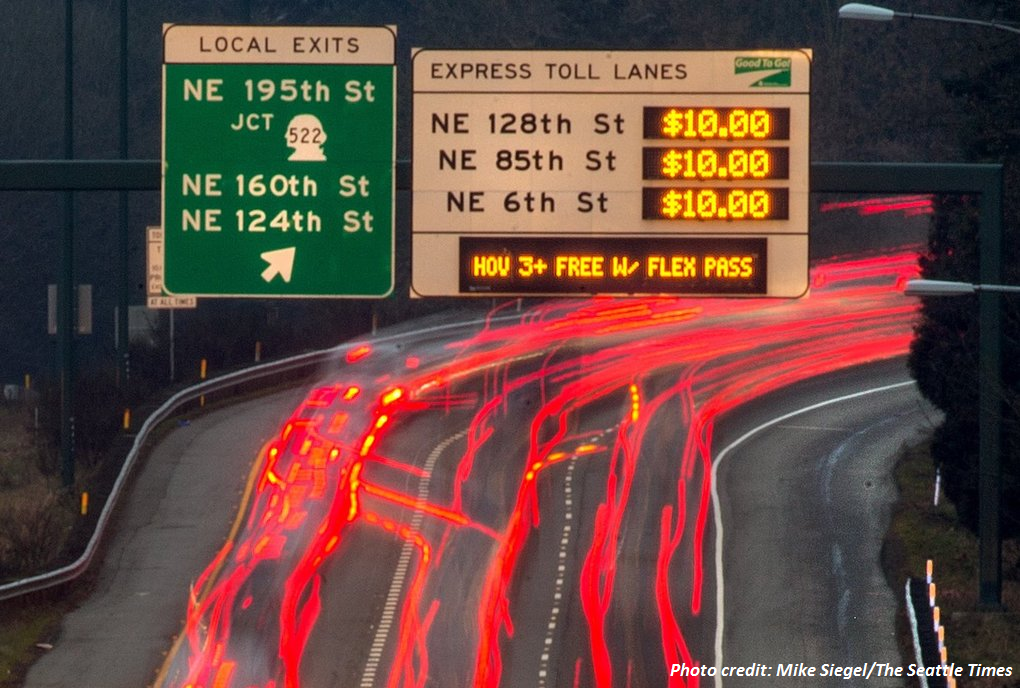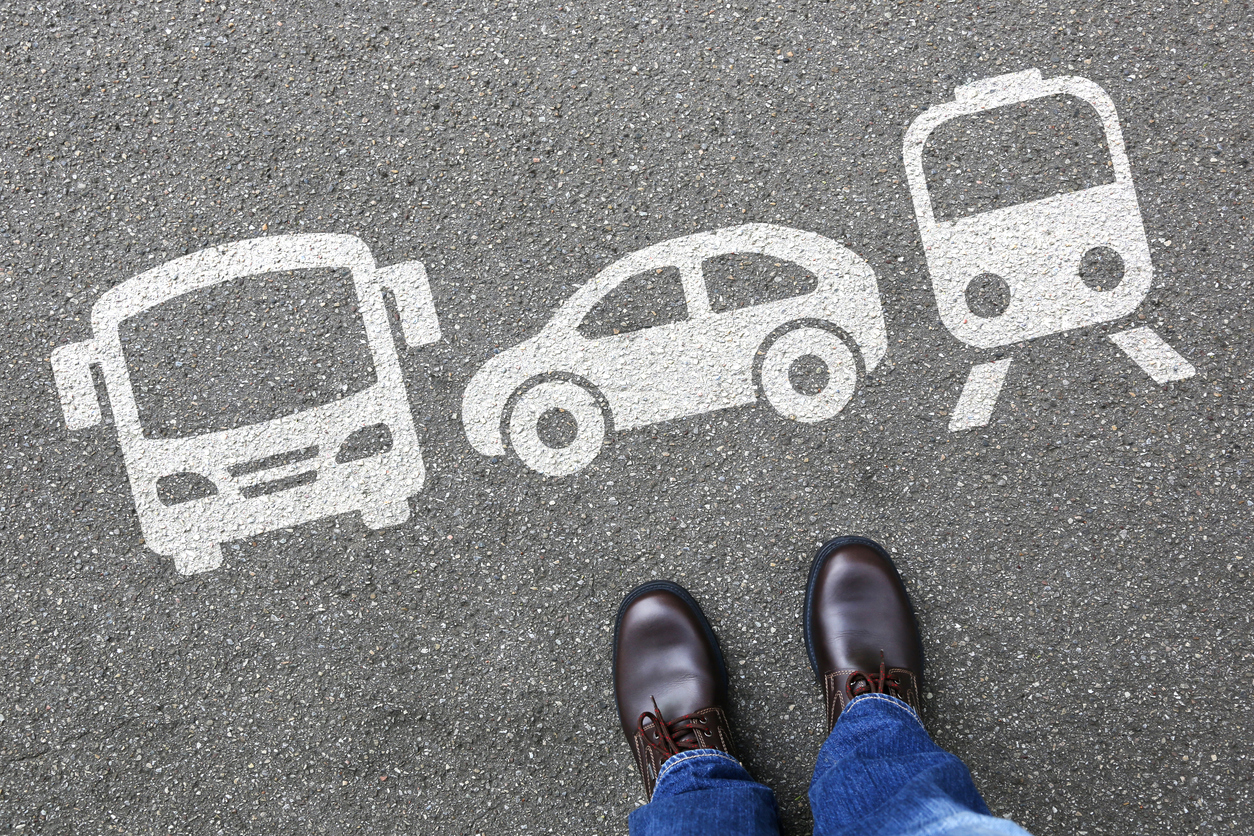In 2003 and 2005, state lawmakers raised the gas tax and promised the public new general purpose lanes on Interstate 405 between Bellevue and Lynnwood. But in 2011, lawmakers approved House Bill 1382, turning the new general purpose lanes into toll lanes. In addition, state lawmakers converted existing High Occupancy Vehicle (HOV) lanes into toll lanes. State officials said the tolling scheme would benefit all users of the highway – including travelers in the regular lanes.
In September 2015, the Washington State Department of Transportation (WSDOT) began its two-year Express Toll Lanes (ETLs) experiment. Despite the end of the trial program in September 2017, WSDOT officials have continued to charge drivers to use the lanes.
To keep the lanes running, state transportation officials need to meet two performance metrics: revenue and speed targets. While state officials say they are meeting the revenue requirement, they admit the lanes are failing federal and state requirements for speed reliability. This was further confirmed by a new University of Minnesota study, which will be presented to the Joint Transportation Committee tomorrow.
The major findings of the study:
- Affirmation of both statutory performance measures for the ETLs;
- Speeds are lower in the ETLs than required by law and general purpose speeds have not improved;
- Provides even more tweaks to I-405 operations to reduce ETL congestion and allow the state to continue charging the public.
This will be the first in a short series of blogs analyzing the University of Minnesota study in detail.
Performance Measures
Besides the state’s revenue requirement, state and federal law requires ETLs or High Occupancy Toll (HOT) lanes to maintain speeds of 45 miles per hour at least 90 percent of the time. State law says that if adequate speeds are not met within the two-year test period, ETLs must be shut down. This is backed by the study author’s assertion that “statute directs the ETL projects on I-405 to be terminated as soon as practicable” if speeds are not met.
Between September 2015 and June 2017, the study finds that during the peak period of travel in the morning (5-9AM, southbound), ETL speeds are above 45 miles per hour just 82 percent of the time. During the peak period of travel in the evening (3-7PM, northbound), ETL speeds are above 45 miles per hour 85 percent of the time.
It appears to be getting worse. Between January and June of this year, southbound speeds met the 45 miles per hour threshold just 78 percent of the time. Northbound travel during this time met the speed threshold 85 percent of the time, revealing that, on average, travel speeds have returned to the “pre-shoulder lane” level.
Applying these results to the plain language of the law couldn’t be clearer. The state project is not meeting its goals and the law calls for converting the highway back to what was originally promised with the gas tax increases in 2003 and 2005. However, that hasn’t stopped WSDOT officials from keeping a tight grip on their toll lanes.
After consulting with their lawyers, WSDOT management thinks they have found a loophole by using a backwards interpretation of state law. State officials have claimed that they only need to meet either the speed or revenue requirement to keep the lanes open (or fail both to shut down).
Yet despite WSDOT’s effort, the report again affirms that the speed criteria “is one of two performance measures that the facility must meet or else state law requires termination of the ETLs.”
WSDOT’s “interpretation” is extremely unlikely to occur in the real world. If we assume that WSDOT’s interpretation is correct, only four scenarios exist:
- The lanes are both profitable and speedy, allowing WSDOT to toll I-405 forever.
- The lanes are profitable, but not speedy. WSDOT can attain profitability because a lot of people use the toll lanes, leading to high tolls and profits - but traffic is dense enough to lower vehicle speeds below the state and federal threshold. According to WSDOT reasoning, this is acceptable and allows them to toll I-405 forever, no matter how jammed the lanes get.
- The lanes are not profitable, but are speedy. This scenario could be met by just a handful of vehicles using the lanes, keeping vehicle speeds high and revenues low. According to WSDOT, this is acceptable and allows them to toll I-405 forever.
- The lanes are jammed with cars (which would lead to high toll revenues and low speeds) but WSDOT can’t cover operating costs, resulting in not meeting the revenue requirement. Yet this is unlikely - the minimum toll rate charged ($0.75) is higher than the average cost of collection – a rate specifically recommended by WSDOT to avoid revenue collection problems. Under WSDOT logic, this is the only scenario that would result in shutdown.
Still, WSDOT insists on this bizarre interpretation of the statute, despite the fact the University of Minnesota study interprets state law the way it is written and understood by everyone else – including lawmakers who voted on the toll authorizing bill.
With that clarification in mind - the study finds that although the ETLs are generating significant revenue for the state, the speed performance measure is not being met.
This means the ETLs should be terminated “as soon as practicable,” a consequence the report ignores because the Joint Transportation Commission did not allow them to consider it.
General Purpose Lane Speeds
The report also states that general purpose lanes have not changed (improved) in any significant way since toll lanes were implemented, one of the main justifications for imposing the I-405 tolling program in the first place. In both the project’s Environmental Assessment and on WSDOT’s website, officials said the tolling program would provide substantial relief to all travelers, not just those who paid to be in the fast lane.
According to the new report, general purpose speeds did improve “immediately following opening of the paved [general purpose lane] shoulder.” In other words, traffic congestion improved when WSDOT added general capacity, not managed capacity (tolls).
Similar to how WSDOT officials have wordsmithed their way around state law regarding the toll lanes, they have also found find a creative way to claim success in general purpose lanes. They have touted lack of improved traffic flow as a win, saying “the general purpose lanes are performing better or about the same as they were prior to the express toll lane system.” Translation: the tolling program is working because traffic has not gotten worse. Officials admit that travel on weekends and between Bothell and Lynnwood is worse than before tolls were implemented.
In tomorrow’s blog, we will begin to cover some of the recommended tweaks from University of Minnesota to improve ETLs, rather than terminate them as promised in statute.






